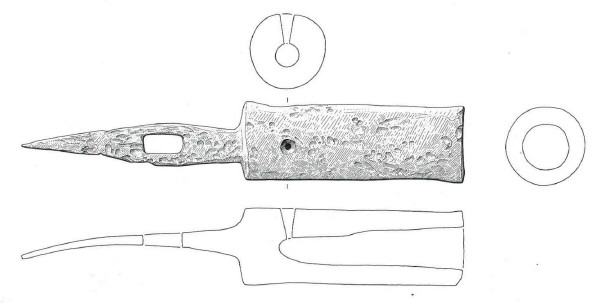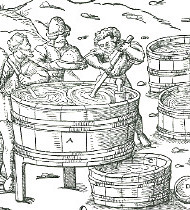The two oldest Handguns of Switzerland
Dear reader, I invite you to switch on your loudspeaker and to enjoy some contemporary renaissance music while reading this.
In the course of an archaeological excavation of the castle of Freienstein, situated in the namesake village of the Canton Zürich, the remains of two handgonnes were found in 1975. According to historical records, the castle burned between 1429 and 1474 and wasn't reconstructed after this. The gonnes were found in the debris together with some swords, locks, and kitchen utensils. Hence the gonnes are certainly older than 1474, probably ca.1380 -1400.
Though, according to the oral history of the locals, the castle became a victim of the "Old Zürich war" (there was also a new one), it's likelier the castle burned accidetally. This theses is underlined by the fact, that expensive artefacts like swords, armours plus a pan from brass were found among the debris, too. Usually castles were looted before setting them afire.
 |
Fig. 1:
Two handgonnes found in the debris of the Freienstein castle, Canton Zürich, Switzerland. |
||
 |
||
| Fig. 2:
Arquebus |
||
 |
||
| Fig. 3:
Handgonne |
||
Comment
In December 2005 I was given the opportunity to study these two gonnes at the Swiss National Museum.
Quite obviously the two gonnes were already scrap when the castle of Freienstein burned in early 15th century.
The breech of the handgonne Fig. 2, which I'm calling arquebus due to its hook, apparently once was sawed off. Considering its section (Fig. 2), it never could be loaded with a bullet, due to its extreme conical core. What we see here is actually only the breech of a former barrel. This is corroborated by the smoothly cut muzzle. Further by the absence of a muzzle bulb, - at that time a stylish must. But why was it sawed off?
The best guess according to my experience is the very unpractical shape of the breech. After seating the bullet, there remained a much too large conical room for the black powder load. So the shooter had two options: Firstly, he had to accept some empty space within the partially loaded breech what then made the ignition difficult. Secondly, he loaded the entire chamber which made a very hefty load. Anticipating a bulk weight of the ancient black powder of ca. 0.7 g/ml and a breech of 57 ml behind the fully seated bullet, the full load was (57 ml x 0.7 g/ml) = 40 g black powder. Help you God!!
To overcome these difficulties, the breech once might have been sawed off, yielding a remaining cylindrical barrel, later closed at its rear end by an iron plug. Presumably a reasonable gonne with this calibre might have had an at least two feet long barrel. So the remaining, improved barrel was still long enough.
What might be the reason handgonne Fig. 3 split? An overload? I'd say no. The barrel with the missing breech looks pretty sturdy. Best guess is: It was a double load. By my personal experience it could be careless training together with friends. While shooting and loading you are talking and joking with your friends, having a cup of coffee or a glass of beer (in my country not prohibited) in between, and soon you find yourself with a double loaded gun. And believe me, that black powder between the two bullets provides an incredible friction! But we will never know this for sure.
Acknowledgement:
I'm greatly indepted to
- Mr. Werner Wild, Archaeological Service of the Canton Zürich, and
- Dr. Mathias Senn, head of the arms collection of the Swiss National Museum, Zürich, especially for introducing me to these two oldest Swiss firearms and providing the photos and the drawings used on this page.
- Drawings by Daniel Pelagatti, Archaeological Service, Canton Zürich
- Copyright of Photos: Archaeological Service of the Canton Zürich
| Fig. 4:
The ruin of Freienstein castle atop of a vineyard in northern Canton Zürich, where the two handgonnes were excavated in 1975. |
|||
Last updated: Sept. 2009
